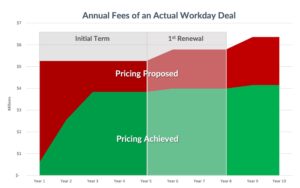- Erwann Couesbot
- Reading Time: 5 minutes

As a leader in the cloud HCM space with growth in Finance and other applications, Workday knows they can price their products at a premium. High upfront costs paired with typical SaaS tactics for increasing costs in perpetuity means Workday TCO risk is greater than you think.
Fortunately, there are many tactics you can use to lower the short- and long-term costs of Workday and make a significant dent in your TCO. How significant? The example below shows how much one of our recent clients was able to save using our techniques to manufacture leverage and negotiate more competitive pricing and commercial terms.

As shown in the chart, Workday initially proposed pricing that would have cost the customer over $5M each year until Year 5 when renewal price increases and other additional costs would kick in and continue to increase year after year.
However, we worked with the customer to build out a customized negotiation strategy to help them not only avoid overpaying for their initial Workday deal, but also attain price protections to avoid being hit with steep annual fee increases at renewal. By implementing various negotiation tactics, the company ultimately achieved an agreement that reduced their TCO by over $11M over 5 years and over $21M over 10 years compared to Workday’s initial proposal. This is just one example but some of the steps they took will apply to any company considering Workday.
How to Reduce Your Workday Costs
While every situation is different, following these three steps to negotiate lower Workday pricing is a great place for any company to start. These steps should be taken every time you purchase a Workday solution, whether it is for a net-new deal or renewal. However, it is especially important to take these actions if you are making your first Workday purchase since this is when you have the most leverage and it is your first deal that sets the precedent for your future Workday agreements.
Step 1: Get Your FSE Counts Right
When considering purchasing a Workday subscription, you will have to determine your number of Full-Service Equivalent (FSE) workers as this is the primary metric Workday uses to price their solutions. For core Workday HCM and Finance solutions, the FSE count will be counted on an enterprise level, but some add-on solutions may have lower FSE counts based on the number of actual users utilizing that particular service.
In general, Workday uses a few different worker categories that each have its own definition and applicable percentage to determine the total FSE worker count. Here is an example of how that works:
| Worker Category | Applicable Workers | Applicable Percentage | FSE Worker Calculation |
|---|---|---|---|
| Salaried Workers | 2,000 | 100% | 2,000 |
| Part-time Workers | 1,000 | 25% | 250 |
| Total Baseline FSE Count | 2,250 | ||
While many companies accept the limited worker categories that Workday suggests, Workday will offer other worker categories to customers on a case-by-case basis. For instance, you may want to add a category for seasonal workers or field workers. The applicable percentage associated with these other types of workers can vary in range from 15% to 65%.
By adding worker types with lower applicable percentages than full-time salaried workers, you may be able to lower your total baseline FSE count. Here is an example of how the total baseline FSE count can change with the addition of worker categories.
Example of Standard FSE Calculation Table
| Worker Category | Applicable Number | Applicable Percentage | FSE Worker Calculation |
|---|---|---|---|
| Category A | ##,### | ##% | 9,500 |
| Category B | ##,### | ##% | 2,000 |
| Category C | ##,### | ##% | 1,000 |
| Total Baseline FSE Count | 12,500 | ||
Example of Extended FSE Calculation Table
| Worker Category | Applicable Number | Applicable Percentage | FSE Worker Calculation |
|---|---|---|---|
| Category A | ##,### | ##% | 6,500 |
| Category B | ##,### | ##% | 1,300 |
| Category C | ##,### | ##% | 500 |
| Category D | ##,### | ##% | 500 |
| Category E | ##,### | ##% | 200 |
| Total Baseline FSE Count | 9,000 | ||
Step 2: Don’t Buy SKUs You Don’t Need
While this may sound obvious, many organizations purchase more SKUs than they actually need, or they purchase them earlier than needed. If Workday offers you a discount for adding additional products, seriously consider if you’ll be able to use those additional products this term. If not, you’ll most likely save money now and in the long run by waiting to purchase it until the time is right.
To avoid making this common mistake, take the time to map your current solution requirements with Workday’s SKUs prior to engaging with Workday. While they may still try to upsell you, knowing what you actually need will prevent Workday from heavily inflating your bill of materials.
Once you have a good understanding of which SKUs you actually require and would like to purchase now, you should also consider other existing solutions that you might need in the future. Instead of paying for those additional SKUs now, you can negotiate with Workday to price protect those SKUs for a specified period of time.
Step 3: Use Benchmarks to Negotiate a Competitive Workday Deal
As is the case with any SaaS provider, getting competitive pricing and a favorable deal structure with Workday depends on the amount of leverage you have. Your leverage will depend on a number of variables such as the size of your company, the size of your purchase, and your expected growth. But even when you’ve identified how much leverage you have, how do you know what pricing to aim for when negotiating?
This is a situation where the old saying ‘knowledge is power’ holds true. Having relevant Workday pricing benchmarks not only adds to your leverage, but it is the best way to know how competitive your pricing is and where your agreement stands in relation to the market.
If you have pricing from existing Workday deals, you can leverage this information. But be careful – not all benchmarks are created equal. Pricing benchmarks expire and benchmarks from an HCM deal made in 2020 is not likely to be applicable for a 2023 HCM solution purchase because products and their functionalities evolve along with how Workday decides to price them.
Workday benchmarks are also specific and won’t apply to every deal. For benchmarks to be relevant in your unique situation, they should come from an agreement with a similar overall deal size, FSE worker count, and SKU mix. You’ll also need to consider the level of leverage the company had when the deal was negotiated even if those other factors all line up.
Assess the Competitiveness of Your Workday Deal
One reason so many companies turn to UpperEdge to help negotiate their Workday deals is because of how valuable relevant and recent benchmarks are in negotiations. If you’re interested in assessing the competitiveness of your current Workday contract or proposal, you may want to take advantage of our limited-time mark-to-market assessment.
This free assessment will use our database of market intelligence to classify the key terms in your agreement on a scale of Out-of-Market to Best-in-Class and prioritize each term, so you know which opportunities to focus on in your Workday negotiations. Request a Complimentary Workday assessment here.

